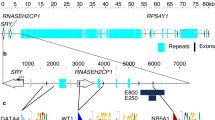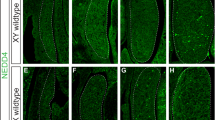Abstract
The mammalian Y chromosome acts as a dominant male determinant as a result of the action of a single gene, Sry, whose role in sex determination is to initiate testis rather than ovary development from early bipotential gonads1,2,3. It does so by triggering the differentiation of Sertoli cells from supporting cell precursors, which would otherwise give follicle cells. The related autosomal gene Sox9 is also known from loss-of-function mutations in mice and humans to be essential for Sertoli cell differentiation4,5; moreover, its abnormal expression in an XX gonad can lead to male development in the absence of Sry6,7. These genetic data, together with the finding that Sox9 is upregulated in Sertoli cell precursors just after SRY expression begins8,9, has led to the proposal that Sox9 could be directly regulated by SRY. However, the mechanism by which SRY action might affect Sox9 expression was not understood. Here we show that SRY binds to multiple elements within a Sox9 gonad-specific enhancer in mice, and that it does so along with steroidogenic factor 1 (SF1, encoded by the gene Nr5a1 (Sf1)), an orphan nuclear receptor. Mutation, co-transfection and sex-reversal studies all point to a feedforward, self-reinforcing pathway in which SF1 and SRY cooperatively upregulate Sox9 and then, together with SF1, SOX9 also binds to the enhancer to help maintain its own expression after that of SRY has ceased. Our results open up the field, permitting further characterization of the molecular mechanisms regulating sex determination and how they have evolved, as well as how they fail in cases of sex reversal.
This is a preview of subscription content, access via your institution
Access options
Subscribe to this journal
Receive 51 print issues and online access
$199.00 per year
only $3.90 per issue
Buy this article
- Purchase on Springer Link
- Instant access to full article PDF
Prices may be subject to local taxes which are calculated during checkout




Similar content being viewed by others
References
Gubbay, J. et al. A gene mapping to the sex-determining region of the mouse Y chromosome is a member of a new family of embryonically expressed genes. Nature 346, 245–250 (1990)
Sinclair, A. H. et al. A gene from the human sex-determining region encodes a protein with homology to a conserved DNA-binding motif. Nature 346, 240–244 (1990)
Koopman, P., Gubbay, J., Vivian, N., Goodfellow, P. & Lovell-Badge, R. Male development of chromosomally female mice transgenic for Sry. . Nature 351, 117–121 (1991)
Foster, J. W. et al. Campomelic dysplasia and autosomal sex reversal caused by mutation in an SRY-related gene. Nature 372, 525–530 (1994)
Chaboissier, M.-C. et al. Functional analysis of Sox8 and Sox9 during sex determination in the mouse. Development 131, 1891–1901 (2004)
Huang, B., Wang, S., Ning, Y., Lamb, A. N. & Bartley, J. Autosomal XX sex reversal caused by duplication of SOX9 . Am. J. Med. Genet. 87, 349–353 (1999)
Vidal, V. P. I., Chaboissier, M.-C., Rooji, D. G. D. & Schedl, A. Sox9 induces testis development in XX transgenic mice. Nature Genet. 28, 216–217 (2001)
Morais da Silva, S. et al. Sox9 expression during gonadal development implies a conserved role for the gene in testis differentiation in mammals and birds. Nature Genet. 14, 62–68 (1996)
Sekido, R., Bar, I., Narváez, V., Penny, G. & Lovell-Badge, R. SOX9 is up-regulated by the transient expression of SRY specifically in Sertoli cell precursors. Dev. Biol. 274, 271–279 (2004)
McElreavey, K., Vilain, E., Abbas, N., Herskowitz, I. & Fellous, M. A regulatory cascade hypothesis for mammalian sex determination: SRY represses a negative regulator of male development. Proc. Natl Acad. Sci. USA 90, 3368–3372 (1993)
Pontiggia, A. et al. Sex-reversing mutations affect the architecture of SRY-DNA complexes. EMBO J. 13, 6115–6124 (1994)
Ohe, K., Lalli, E. & Sassone-Corsi, P. A direct role of SRY and SOX9 proteins in pre-mRNA splicing. Proc. Natl Acad. Sci. USA 99, 1146–1151 (2002)
Thevenet, L. et al. NHERF2/SIP-1 interacts with mouse SRY via a different mechanism than human SRY. J. Biol. Chem. 280, 38625–38630 (2005)
Luo, X., Ikeda, Y. & Parker, K. L. A cell-specific nuclear receptor is essential for adrenal and gonadal development and sexual differentiation. Cell 77, 663–673 (1994)
Lin, L. et al. Heterozygous missense mutations in steroidogenic factor 1 (SF1/Ad4BP, NR5A1) are associated with 46,XY disorders of sex development with normal adrenal function. J. Clin. Endocrinol. Metab. 92, 991–999 (2007)
Park, S. Y. et al. Nuclear receptors Sf1 and Dax1 function cooperatively to mediate somatic cell differentiation during testis development. Development 132, 2415–2423 (2005)
Ikeda, Y. et al. Comparative localization of Dax-1 and Ad4BP/SF-1 during development of the hypothalamic–pituitary–gonadal axis suggests their closely related and distinct function. Dev. Dyn. 220, 363–376 (2001)
Ng, L.-J. et al. SOX9 binds DNA, activates transcription, and coexpresses with type II collagen during chondrogenesis in the mouse. Dev. Biol. 183, 108–121 (1997)
Qin, Y. et al. Long-range activation of Sox9 in Odd Sex (Ods) mice. Hum. Mol. Genet. 13, 1213–1218 (2004)
Wunderle, V. M., Critcher, R., Hastie, N., Goodfellow, P. N. & Schedl, A. Deletion of long-range regulatory elements upstream of SOX9 causes campomelic dysplasia. Proc. Natl Acad. Sci. USA 95, 10649–10654 (1998)
Bagheri-Fam, S. et al. Long-range upstream and downstream enhancers control distinct subsets of the complex spatiotemporal Sox9 expression pattern. Dev. Biol. 291, 382–397 (2006)
Kim, Y. et al. Fgf9 and Wnt4 act as antagonistic signals to regulate mammalian sex determination. PLoS Biol. 4, 1000–1009 (2006)
Kim, Y. et al. Fibriblast growth factor receptor 2 regulates proliferation and Sertoli differentiation during male sex determination. Proc. Natl Acad. Sci. USA 104, 16558–16563 (2007)
de Santa Barbara, P. et al. Direct interaction of SRY-related protein SOX9 and steroidgenic factor 1 regulates transcription of the human anti-Mullerian hormone gene. Mol. Cell. Biol. 18, 6653–6665 (1998)
Arango, N. A., Lovell-Badge, R. & Behringer, R. R. Targeted mutagenesis of the endogenous mouse Mis gene promoter: in vivo definition of genetic pathways of vertebrate sexual development. Cell 99, 409–419 (1999)
Dubin, R. A. & Ostrer, H. Sry is a transcriptional activator. Mol. Endocrinol. 12, 1182–1192 (1994)
Hammes, A. et al. Two splice variants of Wilm’s tumor 1 gene have distinct functions during sex determination and nephron formation. Cell 106, 319–329 (2001)
Wilhelm, D. & Englert, C. The Wilms tumor suppressor WT1 regulates early gonad development by activation of Sf1 . Genes Dev. 16, 1839–1851 (2002)
Kidokoro, T. et al. Influence on spatiotemporal patterns of a male-specific Sox9 activation by ectopic Sry expression during early phases of testis differentiation in mice. Dev. Biol. 278, 511–525 (2005)
Shen, J. H. & Ingraham, H. A. Regulation of the orphan nuclear receptor steroidogenic factor 1 by Sox proteins. Mol. Endocrinol. 16, 529–540 (2002)
Acknowledgements
We thank J. Carvajal and T. Kondo for teaching us BAC engineering and ChIP assays, respectively; D. Bell and S. Wood for help in generating transgenic mice; M. Cheung for analysing neural crest cells in transgenic embryos; K. Parker for providing SF1 complementary DNA and SF1 null mutant mice; A. Schedl for providing conditional Sox9 mutant mice; K. Morohashi for providing the Ad4BP/SF1 antibody; H. Sasaki for providing the Asshsp68lacZ vector; Y. Kamachi for providing the pCMV/SV2-Sox9 and pδ51LucII vectors; and V. Harley and the members of the Division of Developmental Genetics in the National Institute for Medical Research, especially C. Wise, F. W. Buaas, J. Turner and P. Burgoyne, for suggestions and discussions. This work was supported by the Medical Research Council and the Louis Jeantet Foundation. R.S. was a recipient of long-term fellowships from the European Molecular Biology Organization and the Human Frontier Science Program.
Author Contributions R.S. was responsible for most of the experiments, and R.L.B. for a few experiments as well as for directing the laboratory. Both planned the project and wrote the manuscript.
Author information
Authors and Affiliations
Corresponding authors
Supplementary information
Supplementary information
The file contains Supplementary Figures 1-6 with Legends and additional references. (PDF 5812 kb)
Supplementary information
This file contains Supplementary Methods. The Supplementary Methods for this Letter should have been uploaded at the time of publication. This oversight has now been rectified. See corresponding erratum (doi:10.1038/nature07622). (PDF 349 kb)
Rights and permissions
About this article
Cite this article
Sekido, R., Lovell-Badge, R. Sex determination involves synergistic action of SRY and SF1 on a specific Sox9 enhancer. Nature 453, 930–934 (2008). https://doi.org/10.1038/nature06944
Received:
Accepted:
Published:
Issue Date:
DOI: https://doi.org/10.1038/nature06944
This article is cited by
-
A novel c.64G > T (p.G22C) NR5A1 variant in a Chinese adolescent with 46,XY disorders of sex development: a case report
BMC Pediatrics (2023)
-
Androgen insensitivity syndrome: a review
Journal of Endocrinological Investigation (2023)
-
UHRF1 establishes crosstalk between somatic and germ cells in male reproduction
Cell Death & Disease (2022)
-
Loss of NEDD4 causes complete XY gonadal sex reversal in mice
Cell Death & Disease (2022)
-
Mammalian X-chromosome inactivation: proposed role in suppression of the male programme in genetic females
Journal of Genetics (2022)
Comments
By submitting a comment you agree to abide by our Terms and Community Guidelines. If you find something abusive or that does not comply with our terms or guidelines please flag it as inappropriate.



